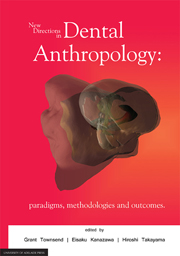Book contents
- Frontmatter
- Foreword
- Contents
- 1 Modelling the complexity of the dentition
- 2 New approaches to dental anthropology based on the study of twins
- 3 Genes for teeth — drawing inference from family data
- 4 Do feeding practices, gestation length, and birth weight affect the timing of emergence of the first primary tooth?
- 5 Sexual dimorphism in the primary and permanent dentitions of twins: an approach to clarifying the role of hormonal factors
- 6 Dental crown and arch size in Europeans and Australian Aboriginals
- 7 Sex determination from maxillary and mandibular canines of the Filipino population
- 8 Non-metric dental characteristics in Papua New Guinea Highlanders and their association with molar reduction
- 9 The Main Occluding Area between opposing teeth during chewing: a comparison between Australians and Japanese
- 10 “Mineral Maintenance” of dental structures in caries and erosive tooth wear: an holistic model
- 11 Emerging techniques for the analysis of tooth wear
3 - Genes for teeth — drawing inference from family data
Published online by Cambridge University Press: 05 May 2013
- Frontmatter
- Foreword
- Contents
- 1 Modelling the complexity of the dentition
- 2 New approaches to dental anthropology based on the study of twins
- 3 Genes for teeth — drawing inference from family data
- 4 Do feeding practices, gestation length, and birth weight affect the timing of emergence of the first primary tooth?
- 5 Sexual dimorphism in the primary and permanent dentitions of twins: an approach to clarifying the role of hormonal factors
- 6 Dental crown and arch size in Europeans and Australian Aboriginals
- 7 Sex determination from maxillary and mandibular canines of the Filipino population
- 8 Non-metric dental characteristics in Papua New Guinea Highlanders and their association with molar reduction
- 9 The Main Occluding Area between opposing teeth during chewing: a comparison between Australians and Japanese
- 10 “Mineral Maintenance” of dental structures in caries and erosive tooth wear: an holistic model
- 11 Emerging techniques for the analysis of tooth wear
Summary
ABSTRACT
Development of the human dentition, a complex, self-organising system, is underpinned by a series of reiterative steps involving a number of key gene pathways, supplemented by smaller influences of a polygenic background. Modelling familial data of dental phenotypes can help to unravel genetic and environmental influences. This paper presents a review of a number of model-based approaches that can be useful analytically, with a focus on twins as the familial structure to elaborate genetic complexity. Genetic modelling is methodologically robust, and provides a framework within which to locate evidence of gene effects from modern, high-throughput genotyping approaches. The twin family structure is particularly well-suited to this approach, and provides a number of distinct advantages analytically, particularly in the presence of population stratification.
INTRODUCTION
The human dentition is of significant anthropological interest when considering variation within and between modern populations. It is also a useful tool for examining evolutionary change over time in response to changes in culture, diet, etc. Teeth provide a (relatively) stable indirect source of information about processes occurring during pre- and early post-natal development. They are also one of the most stable sources of information in the fossil record, both morphologically, and as a repository of ancient DNA sequence information (Adler et al., 2010). Furthermore, variation in tooth form and function can provide opportunities for examining inter-individual variation as a means for forensic identification.
- Type
- Chapter
- Information
- New Directions in Dental AnthropologyParadigms, Methodologies and Outcomes, pp. 22 - 34Publisher: The University of Adelaide PressPrint publication year: 2012
- 6
- Cited by



